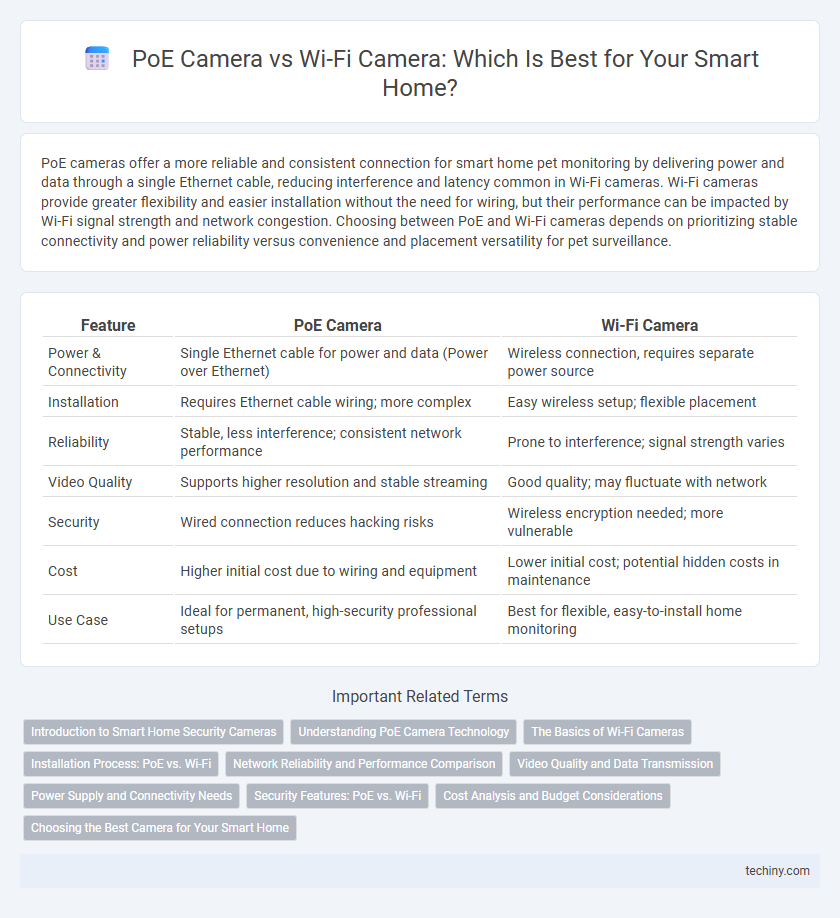PoE cameras offer a more reliable and consistent connection for smart home pet monitoring by delivering power and data through a single Ethernet cable, reducing interference and latency common in Wi-Fi cameras. Wi-Fi cameras provide greater flexibility and easier installation without the need for wiring, but their performance can be impacted by Wi-Fi signal strength and network congestion. Choosing between PoE and Wi-Fi cameras depends on prioritizing stable connectivity and power reliability versus convenience and placement versatility for pet surveillance.
Table of Comparison
| Feature | PoE Camera | Wi-Fi Camera |
|---|---|---|
| Power & Connectivity | Single Ethernet cable for power and data (Power over Ethernet) | Wireless connection, requires separate power source |
| Installation | Requires Ethernet cable wiring; more complex | Easy wireless setup; flexible placement |
| Reliability | Stable, less interference; consistent network performance | Prone to interference; signal strength varies |
| Video Quality | Supports higher resolution and stable streaming | Good quality; may fluctuate with network |
| Security | Wired connection reduces hacking risks | Wireless encryption needed; more vulnerable |
| Cost | Higher initial cost due to wiring and equipment | Lower initial cost; potential hidden costs in maintenance |
| Use Case | Ideal for permanent, high-security professional setups | Best for flexible, easy-to-install home monitoring |
Introduction to Smart Home Security Cameras
Smart home security cameras enhance property safety by providing real-time monitoring and remote access capabilities. PoE cameras offer reliable power and data transmission through a single Ethernet cable, ensuring stable connectivity and consistent video quality. Wi-Fi cameras provide flexible installation without wiring but may face interference issues and require regular battery maintenance.
Understanding PoE Camera Technology
PoE (Power over Ethernet) cameras utilize a single Ethernet cable to transmit both power and data, ensuring reliable connectivity and consistent video quality without the interference common in Wi-Fi networks. This technology supports higher bandwidth for HD video streaming and reduces installation complexity by eliminating the need for separate power supplies. PoE cameras offer enhanced security with encrypted wired connections, making them ideal for smart home surveillance systems requiring stable, high-performance monitoring.
The Basics of Wi-Fi Cameras
Wi-Fi cameras connect wirelessly to a home network, offering easy installation without the need for cables. They rely on Wi-Fi signals for power and data transmission, making them flexible but dependent on network strength and stability. Common features include remote access via smartphone apps, motion detection, and cloud storage options for recorded footage.
Installation Process: PoE vs. Wi-Fi
PoE cameras simplify installation by transmitting power and data through a single Ethernet cable, reducing the need for separate power sources and minimizing cable clutter. Wi-Fi cameras offer more flexible placement without wiring constraints but often require reliable wireless signals and separate power adapters. For large-scale smart home setups, PoE provides a more stable and scalable installation process compared to Wi-Fi cameras.
Network Reliability and Performance Comparison
PoE cameras offer superior network reliability by delivering both power and data through a single Ethernet cable, reducing signal interference and ensuring consistent connectivity, especially in environments with numerous wireless devices. Wi-Fi cameras depend on wireless signals susceptible to congestion, interference, and range limitations, which can cause latency and dropped connections. For critical monitoring and high-resolution streaming, PoE cameras provide more stable bandwidth and lower latency compared to the variable performance of Wi-Fi cameras.
Video Quality and Data Transmission
PoE cameras provide superior video quality through stable, high-bandwidth wired connections that support uncompressed, high-definition streams without interference. Wi-Fi cameras depend on wireless signals subject to bandwidth fluctuations and environmental interference, which can degrade video clarity and cause latency. Data transmission in PoE systems benefits from consistent power and data delivery over a single Ethernet cable, ensuring uninterrupted, low-latency video streaming compared to the variable performance of Wi-Fi networks.
Power Supply and Connectivity Needs
PoE cameras rely on Power over Ethernet technology, delivering power and data through a single cable, ensuring stable connectivity and eliminating the need for separate power supplies. Wi-Fi cameras depend on wireless networks for data transmission and require dedicated power sources, often batteries or external adapters, which may limit placement flexibility and demand frequent maintenance. PoE systems provide enhanced reliability and reduced cable clutter, while Wi-Fi cameras offer easier installation but can experience interference and connectivity drops.
Security Features: PoE vs. Wi-Fi
PoE cameras offer enhanced security through direct Ethernet connections, reducing the risk of signal interference and hacking compared to Wi-Fi cameras, which rely on wireless networks vulnerable to unauthorized access. PoE systems support encrypted data transmission and centralized power management, making them less susceptible to power outages and network disruptions. In contrast, Wi-Fi cameras depend on strong wireless encryption protocols like WPA3 and frequent firmware updates to maintain security integrity.
Cost Analysis and Budget Considerations
PoE cameras typically involve higher initial costs due to Ethernet cabling and PoE switches but offer lower long-term expenses through stable power supply and reduced maintenance. Wi-Fi cameras present a lower upfront investment with easy wireless installation but may incur additional costs from signal interference, frequent battery replacements, or network upgrades. Budget considerations should weigh the trade-off between PoE's reliability and scalability versus Wi-Fi's flexibility and potential hidden costs over time.
Choosing the Best Camera for Your Smart Home
PoE cameras offer reliable, high-quality video streaming with consistent power through a single Ethernet cable, making them ideal for stable indoor and outdoor surveillance in smart homes. Wi-Fi cameras provide flexible installation and easy access via wireless networks but may experience interference and require frequent charging or power sources. Choosing the best camera depends on your home's network infrastructure, desired video quality, and installation convenience.
PoE Camera vs Wi-Fi Camera Infographic

 techiny.com
techiny.com